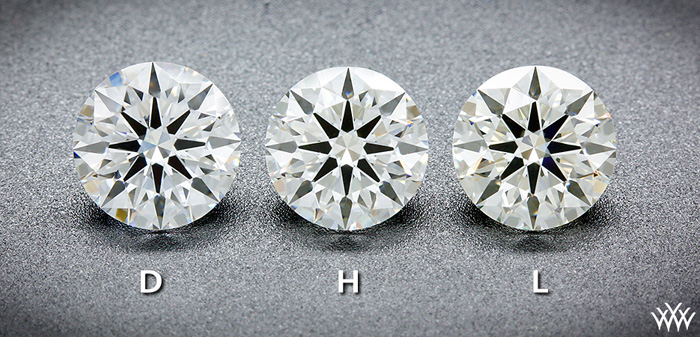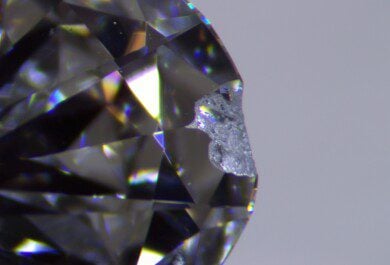Diamond Grading – The AGSL Way (part three)
*The following article is part of a series written in collaboration with the American Gem Society Laboratories. Special thanks to Alethea Inns, C.G., Director of Diamond Grading at AGSL for her technical contributions..
A diamond’s color (or lack thereof) is a critical aspect in determining its market value. Grading the color is therefore a crucial part of the laboratory certification process. The following article will illuminate the various steps and considerations in performing color grading at the AGSL. Other laboratories have different practices.

Because of the central role color plays in the valuation of diamonds, accuracy and consistency are paramount goals for the lab. As we will see in this article, many overlapping cross-checks are used to achieve those goals. At AGSL, color grades are ultimately assigned by graders using a variety of tools. Color grading is performed in a dedicated room with a highly controlled environment including industry standard daylight equivalent lighting, limited ambient light, and color-neutral backgrounds.
During the pre-grading assessment a colorimeter may be used to get a photometric assessment of color as a baseline, but human grading is required in order to account for subtle nuances that machines are not fully capable of detecting. The diamond being graded is compared to a master set of diamonds, and a minimum of two graders look at each stone being color graded, while larger diamonds require more opinions of senior graders.
Diamond Master Sets
The AGSL has multiple sets of color masters, although one set is used primarily in order to achieve maximum grading consistency. Because AGSL and most other labs in the world use the GIA system of color grading, each AGSL master stone has been graded by the GIA to promote uniformity in grading between the labs. Master sets are assembled according to GIA guidelines and a concerted effort is made to stay within gemological tolerance of GIA color grades.
Working methodically, graders determine whether the diamond being graded has more, or less, or the same color as a master. The grader must avoid letting the diamonds being compared contact one another in order to prevent “color bleed” which inhibits the ability to perceive subtle color shades.
AGSL Color grading is done in shifts, with each set of graders working in the color grading room for no more than one hour at a time. This is done in order to eliminate potential issues caused by eye exhaustion. Graders are assessed for color proficiency and all graders are involved in clarity and finish grading as well as color grading.

One carat AGS certified Ideal Cut Diamonds – body color
Color grading of diamonds in the normal range (D-Z) is performed by viewing the diamond through the body of the stone at a viewing distance of 12-15 inches. While the face up view is also analyzed as a final check, the amount of ambient light returned in this view tends to disguise body color. (This is one of the many benefits of ideal cut diamonds.)

One Carat AGS Certified Ideal Cut Diamonds – Face Up
Fancy shapes are color graded at a viewing angle half way between length and width in order to provide balance between the maximum and minimum path length to the observer. For example, a marquise is neither viewed down the long axis (on end) where color would be most apparent, nor directly from the side (short axis) where color would be least apparent. Rather, the stone is graded from a 45 degree angle between the two directions giving a more accurate read on the color actually present. Fancy shapes also tend to collect color in locations according to their facet arrangement and proportion sets (girdle thickness, crown height, etc.). Color graders are trained to minimize this effect in their grading. Facet arrangement can impact the color grade of fancy shapes to a greater extent than rounds which have a uniform arrangement and path length. Finally, fancy shape facet arrangements can also conceal or reveal color zoning in much more readily than in rounds.
An important part of color grading is assessing fluorescence. A significant percentage of diamonds on the market (GIA estimates up to 35%) exhibit this property. When exposed to ultraviolet light sources these diamonds temporarily emit light of different colors (usually blue) and different strengths. While fluorescence is normally just an identifying characteristic, in some cases it can affect the appearance of the diamond.
Fluorescence is assessed with the aid of a set of fluorescent master stones and is viewed in the face up position. Interestingly, fluorescence can occur in localized zones within the diamond and can be more or less visible depending on the viewing angle. A vivid example of this phenomenon is the diamond pictured below.

Fluorescence seen at different viewing angles exhibiting different intensities
There is a slight difference between AGSL and GIA in the way they report on fluorescence. GIA uses two distinct descriptors “None” and “Faint” for diamonds with minimal fluorescence whereas AGSL combines the two in the term “Negligible”. Therefore it is possible in some cases that diamonds deemed “Negligible” by AGSL can have minor levels of fluorescence detectable under UV light.
Color grading of diamonds in the “fancy” color range, those with color past Z, involves a more complex analysis. In addition to determining the relative presence of color, as is the case with grading in the normal range, fancy color diamond grading entails determination of primary hue, modifying hues, saturation and intensity. AGSL does not currently color grade fancy color diamonds.
Conclusion
AGSL color grading calls are made by highly trained professional graders working in highly controlled environments, with the most modern equipment and aids, and using the best practices for accuracy and consistency. The fact that each grade is in fact a very small color range necessarily implies that a given diamond can be right “on the fence” between two colors. Given the number of variables that must be controlled for, it is generally understood that there is a gemological tolerance of one color grade possible between even the top labs such as GIA and AGSL.
by Bryan Boyne, G.G.
Vice President
Whiteflash Inc.

See the other installments of this series:
Part One: Laboratory Graded Diamonds – What are the benefits for the consumer?
Part Two: Diamond Laboratory Process- Basic Functions and Procedures
Part Four: AGS Laboratories – Clarity Grading of Diamonds
Click here to discuss on the Forum
















